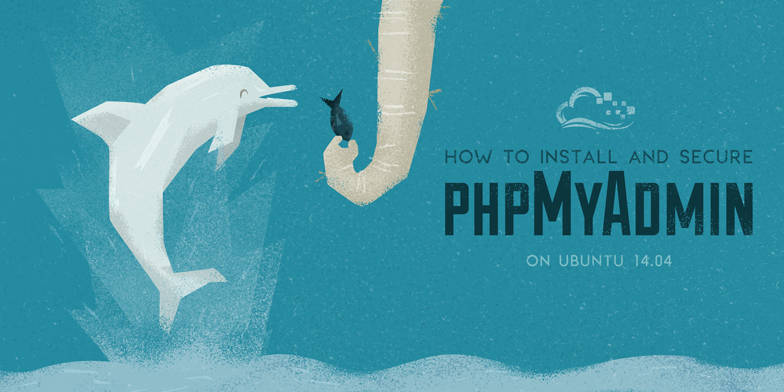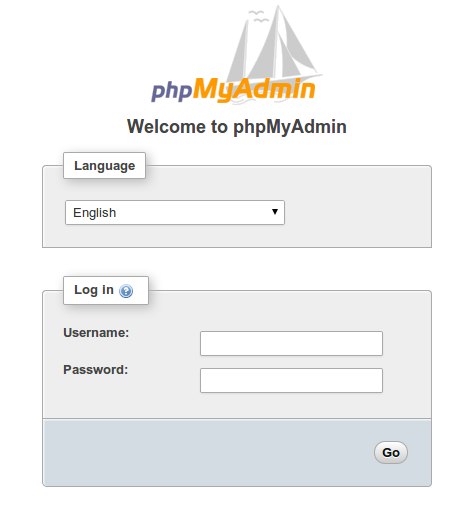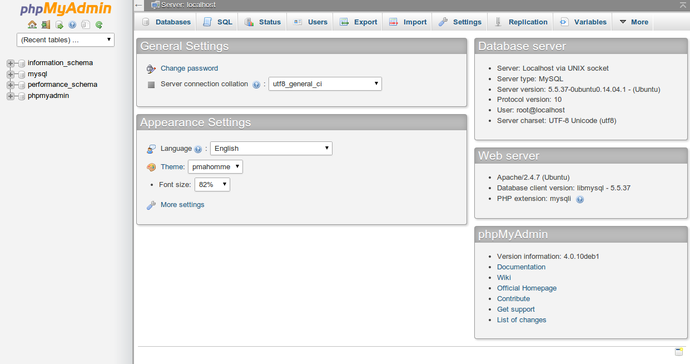- Log in to:
- Community
- DigitalOcean
- Sign up for:
- Community
- DigitalOcean
Not using Ubuntu 14.04?
Choose a different version or distribution.
Introduction
While many users need the functionality of a database management system like MySQL, they may not feel comfortable interacting with the system solely from the MySQL prompt.
phpMyAdmin was created so that users can interact with MySQL through a web interface. In this guide, we’ll discuss how to install and secure phpMyAdmin so that you can safely use it to manage your databases on Ubuntu 14.04.
Note: phpMyAdmin can be installed automatically on your Droplet by adding this script to its User Data when launching it. Check out this tutorial to learn more about Droplet User Data.
Prerequisites
Before you get started with this guide, you need to have some basic steps completed.
First, we’ll assume that you are using a non-root user with sudo privileges, as described in steps 1-4 in the initial server setup of Ubuntu 14.04.
We’re also going to assume that you’ve completed a LAMP (Linux, Apache, MySQL, and PHP) installation on your Ubuntu 14.04 server. If this is not completed yet, you can follow this guide on installing a LAMP stack on Ubuntu 14.04.
Once you are finished with these steps, you’re ready to get started with this guide.
Step One — Install phpMyAdmin
To get started, we can simply install phpMyAdmin from the default Ubuntu repositories.
We can do this by updating our local package index and then using the apt packaging system to pull down the files and install them on our system:
sudo apt-get update
sudo apt-get install phpmyadmin
This will ask you a few questions in order to configure your installation correctly.
Warning
When the first prompt appears, apache2 is highlighted, but not selected. If you do not hit “SPACE” to select Apache, the installer will not move the necessary files during installation. Hit “SPACE”, “TAB”, and then “ENTER” to select Apache.
- For the server selection, choose apache2.
- Select yes when asked whether to use
dbconfig-commonto set up the database - You will be prompted for your database administrator’s password
- You will then be asked to choose and confirm a password for the
phpMyAdminapplication itself
The installation process actually adds the phpMyAdmin Apache configuration file into the /etc/apache2/conf-enabled/ directory, where it is automatically read.
The only thing we need to do is explicitly enable the php5-mcrypt extension, which we can do by typing:
sudo php5enmod mcrypt
Afterwards, you’ll need to restart Apache for your changes to be recognized:
sudo service apache2 restart
You can now access the web interface by visiting your server’s domain name or public IP address followed by /phpmyadmin:
<pre> http://<span class=“highlight”>domain_name_or_IP</span>/phpmyadmin </pre>

You can now log into the interface using the root username and the administrative password you set up during the MySQL installation.
When you log in, you’ll see the user interface, which will look something like this:

Step Two — Secure your phpMyAdmin Instance
We were able to get our phpMyAdmin interface up and running fairly easily. However, we are not done yet. Because of its ubiquity, phpMyAdmin is a popular target for attackers. We need to secure the application to help prevent unauthorized use.
One of the easiest way of doing this is to place a gateway in front of the entire application. We can do this using Apache’s built-in .htaccess authentication and authorization functionalities.
Configure Apache to Allow .htaccess Overrides
First, we need to enable the use of .htaccess file overrides by editing our Apache configuration file.
We will edit the linked file that has been placed in our Apache configuration directory:
sudo nano /etc/apache2/conf-available/phpmyadmin.conf
We need to add an AllowOverride All directive within the <Directory /usr/share/phpmyadmin> section of the configuration file, like this:
<pre> <Directory /usr/share/phpmyadmin> Options FollowSymLinks DirectoryIndex index.php <span class=“highlight”>AllowOverride All</span> . . . </pre>
When you have added this line, save and close the file.
To implement the changes you made, restart Apache:
sudo service apache2 restart
Create an .htaccess File
Now that we have enabled .htaccess use for our application, we need to create one to actually implement some security.
In order for this to be successful, the file must be created within the application directory. We can create the necessary file and open it in our text editor with root privileges by typing:
sudo nano /usr/share/phpmyadmin/.htaccess
Within this file, we need to enter the following information:
AuthType Basic
AuthName "Restricted Files"
AuthUserFile /etc/phpmyadmin/.htpasswd
Require valid-user
Let’s go over what each of these lines mean:
- AuthType Basic: This line specifies the authentication type that we are implementing. This type will implement password authentication using a password file.
- AuthName: This sets the message for the authentication dialog box. You should keep this generic so that unauthorized users won’t gain any information about what is being protected.
- AuthUserFile: This sets the location of the password file that will be used for authentication. This should be outside of the directories that are being served. We will create this file shortly.
- Require valid-user: This specifies that only authenticated users should be given access to this resource. This is what actually stops unauthorized users from entering.
When you are finished, save and close the file.
Create the .htpasswd file for Authentication
Now that we have specified a location for our password file through the use of the AuthUserFile directive within our .htaccess file, we need to create this file.
We actually need an additional package to complete this process. We can install it from our default repositories:
sudo apt-get install apache2-utils
Afterward, we will have the htpasswd utility available.
The location that we selected for the password file was “/etc/phpmyadmin/.htpasswd”. Let’s create this file and pass it an initial user by typing:
<pre> sudo htpasswd -c /etc/phpmyadmin/.htpasswd <span class=“highlight”>username</span> </pre>
You will be prompted to select and confirm a password for the user you are creating. Afterwards, the file is created with the hashed password that you entered.
If you want to enter an additional user, you need to do so without the -c flag, like this:
<pre> sudo htpasswd /etc/phpmyadmin/.htpasswd <span class=“highlight”>additionaluser</span> </pre>
Now, when you access your phpMyAdmin subdirectory, you will be prompted for the additional account name and password that you just configured:
<pre> http://<span class=“highlight”>domain_name_or_IP</span>/phpmyadmin </pre>

After entering the Apache authentication, you’ll be taken to the regular phpMyAdmin authentication page to enter your other credentials. This will add an additional layer of security since phpMyAdmin has suffered from vulnerabilities in the past.
Conclusion
You should now have phpMyAdmin configured and ready to use on your Ubuntu 14.04 server. Using this interface, you can easily create databases, users, tables, etc., and perform the usual operations like deleting and modifying structures and data.
To learn how to further secure your interactions with the server by encrypting your communication with SSL, check out our article on setting up SSL certificates with phpMyAdmin.
<div class=“author”>By Justin Ellingwood</div>
Thanks for learning with the DigitalOcean Community. Check out our offerings for compute, storage, networking, and managed databases.
About the author
Former Senior Technical Writer at DigitalOcean, specializing in DevOps topics across multiple Linux distributions, including Ubuntu 18.04, 20.04, 22.04, as well as Debian 10 and 11.
Still looking for an answer?
This textbox defaults to using Markdown to format your answer.
You can type !ref in this text area to quickly search our full set of tutorials, documentation & marketplace offerings and insert the link!
Hey! Thanks for the tutorial. I ran into a problem though, I get a 404 not found error when visiting http://myserver/phpmyadmin/ (where ‘myserver’ is my ip adress’). The strange thing is that the PMA favicon is showing. When I visit http://myserver/ the apache configuration page shows fine. Any idea why phpmyadmin can’t be found?
Thanks! Nic
Could you post any relevant information from your Apache log?
<pre> tail /var/log/apache2/error.log </pre>
The log doesn’t show any relevant information, only multiple instances of this: <pre> [Thu Apr 24 10:55:18.746603 2014] [core:notice] [pid 10813] AH00094: Command line: ‘/usr/sbin/apache2’ [Thu Apr 24 10:59:56.400419 2014] [mpm_prefork:notice] [pid 10813] AH00169: caught SIGTERM, shutting down [Thu Apr 24 10:59:57.489426 2014] [mpm_prefork:notice] [pid 10873] AH00163: Apache/2.4.7 (Ubuntu) PHP/5.5.9-1ubuntu4 configured – resuming normal operations </pre> But I got it to work. Strangely I didn’t find any phpmyadmin conf file in <code>/etc/apache2/conf-enabled/</code>, so I used the method as described in the Ubuntu 12.04 tutorial and included phpmyadmin’s conf file in <code>/etc/apache2/apache2.conf</code>. For the .htaccess security procedures I used the conf file in the phpmyadmin directory. Everything now works as it should :)
I think why it didn’t work is because the phpmyadmin.conf file was not added to the <code>/etc/apache2/conf-enabled/</code> directory. Do you know why this might be the case?
The .conf file for me wasn’t put in the right place either. You need to manually copy it over like this:
sudo cp /etc/phpmyadmin/apache.conf /etc/apache2/conf-enabled/phpmyadmin.conf
Got an 404 error when I access http://domain_name_or_IP/phpmyadmin
Solution: manually copy over the the PHPMyAdmin Apache conf file over to the conf-available directory:
sudo cp /etc/phpmyadmin/apache.conf /etc/apache2/conf-available/phpmyadmin.conf
Then enabled the Apache conf file using a2enconf:
sudo a2enconf phpmyadmin
Thanks for the heads up everyone.
The problems that you are describing indicate that you never actually selected “Apache” for your web server during the phpMyAdmin installation processes. Although that option is highlighted by the installer, you need to hit “SPACE” to check the box and select that option.
This is the part of the configuration that lets phpMyAdmin know that you wish to move the files into the Apache configuration hierarchy.
I have updated the guide to make this a bit more clear. Please let us know if you have any additional problems.
Hi This is the best i have seen for some time i spent 2 weeks trying to get server 2008 r2 to do the same thing and it took me about 2 hours to do the full install and configure this.
well done ubuntu you won me over… Many thanks
Richard C
Thanks for the tutorial. Very helpful. Just have one question. How to I change the phpmyadmin default http directory? I mean I don’t want to use http://ip/phpmyadmin as visiting link because it’s too easy to guess.
Thanks!
@yalunren: To change the url, edit the phpmyadmin.conf file:
<pre> sudo nano /etc/apache2/conf-available/phpmyadmin.conf </pre>
File the “Alias” line and change the first part to the url you want. For instance, change:
<pre> Alias /phpmyadmin /usr/share/phpmyadmin </pre>
to
<pre> Alias /somethingelse /usr/share/phpmyadmin </pre>
Then restart Apache:
<pre> sudo service apache2 restart </pre>
Now, phpmyadmin is available at http://your.ip.address/somethingelse
- Table of contents
- Prerequisites
- Step One — Install phpMyAdmin
- Step Two — Secure your phpMyAdmin Instance
- Conclusion
Deploy on DigitalOcean
Click below to sign up for DigitalOcean's virtual machines, Databases, and AIML products.
Become a contributor for community
Get paid to write technical tutorials and select a tech-focused charity to receive a matching donation.
DigitalOcean Documentation
Full documentation for every DigitalOcean product.
Resources for startups and SMBs
The Wave has everything you need to know about building a business, from raising funding to marketing your product.
Get our newsletter
Stay up to date by signing up for DigitalOcean’s Infrastructure as a Newsletter.
New accounts only. By submitting your email you agree to our Privacy Policy
The developer cloud
Scale up as you grow — whether you're running one virtual machine or ten thousand.
Get started for free
Sign up and get $200 in credit for your first 60 days with DigitalOcean.*
*This promotional offer applies to new accounts only.
